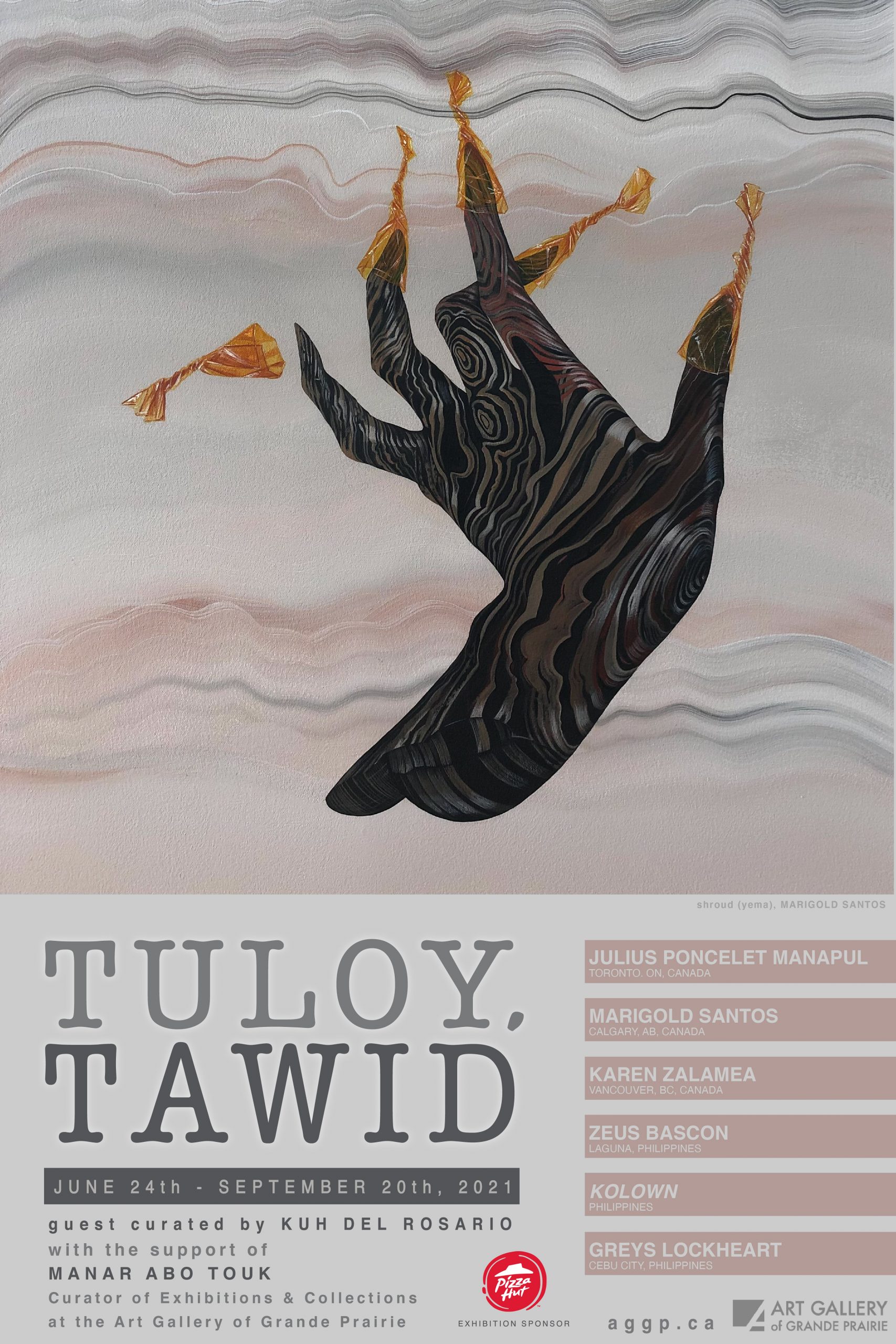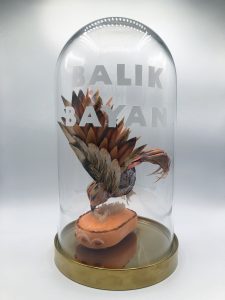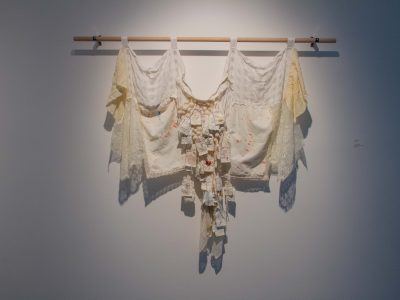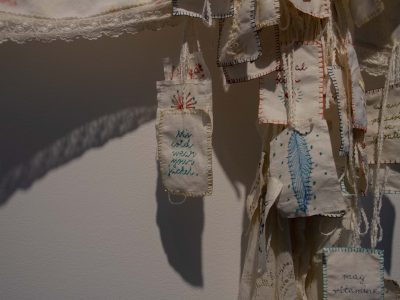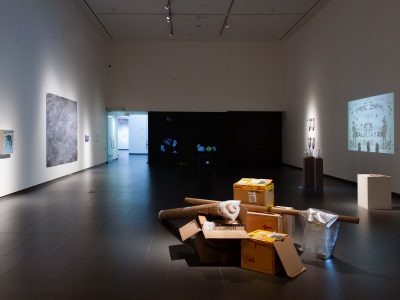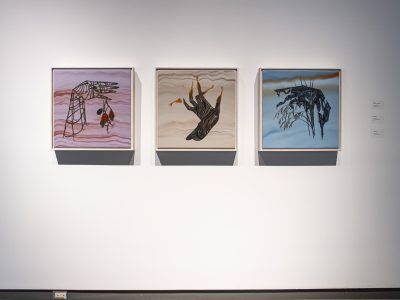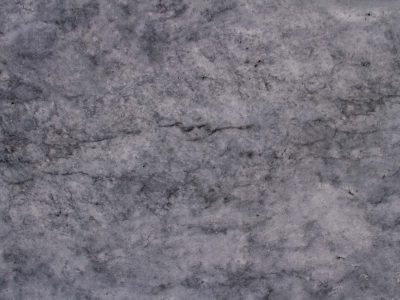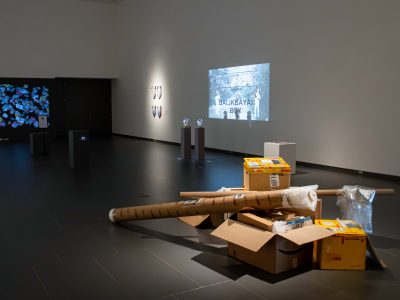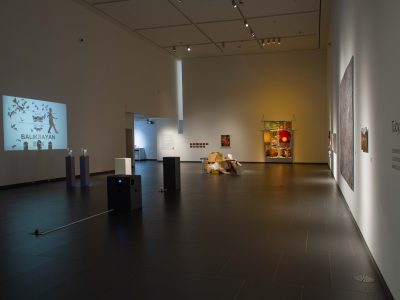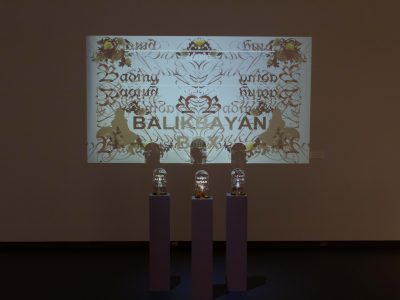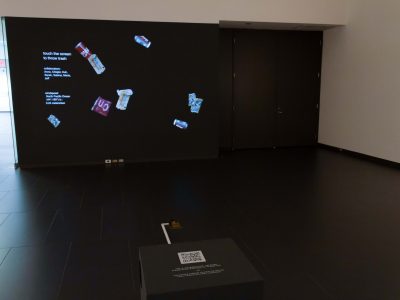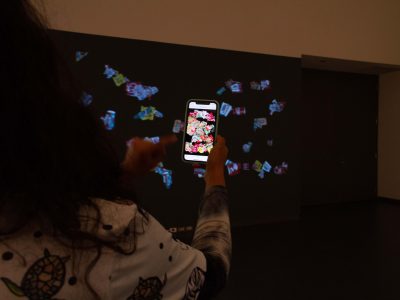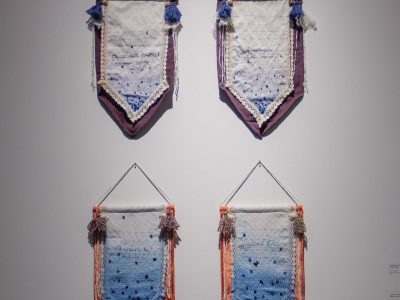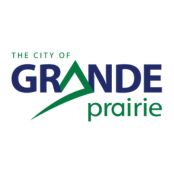Group Exhibition
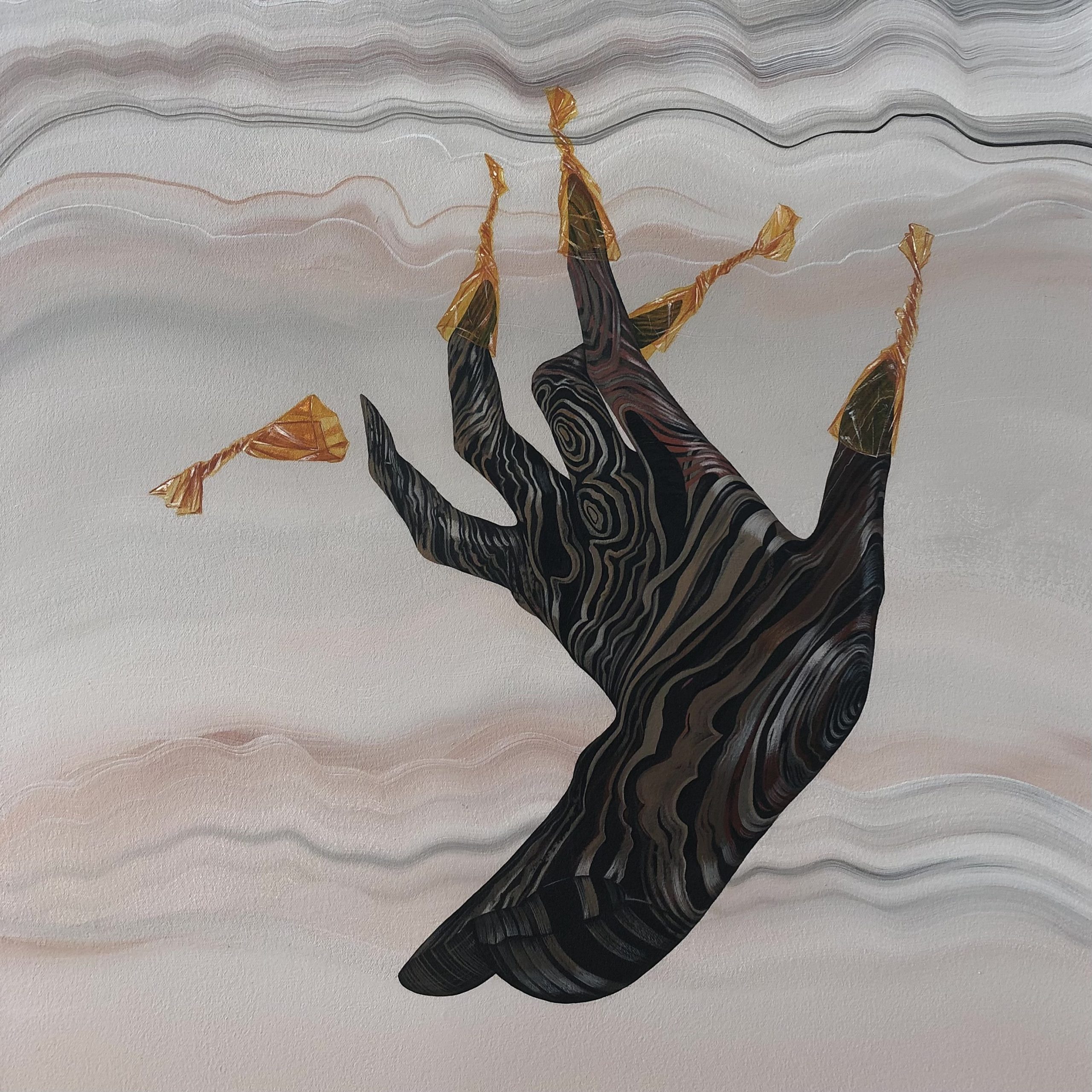
Tuloy, Tawid
Group Exhibition
June 24, 2021 - September 20, 2021
Tuloy, Tawid directly translates to ‘Continue, Cross.’
When visiting Filipino households, it is not unusual to be greeted with an impassioned tuloy! upon arrival. “Tuloy po kayo” or “please come in,” denotes hospitality, coaxing those to come inside. To cross the threshold is to accept the kindness that has been extended. Tuloy denotes the beginning of a reciprocal exchange of shared intimacy.
Tawid is to cross,
over a bridge or terrain.
from one point to another,
covering ground,
reaching a destination,
overcoming distance.
The title situates the exhibition as inclusive, making way for discourse that privileges the telling of stories not often told, or not told enough. Tuloy, Tawid welcomes one to continue the crossing – to take action toward a deeper understanding.
Through the unique perspective and geographical position of each artist, Tuloy, Tawid offers an exhibition with both breadth and specificity, at once. Featuring works by artists – Zeus Bascon (Laguna, Philippines), KoloWn (Philippines), Greys Lockheart (Cebu City, Philippines), Julius Poncelet Manapul (Toronto, Canada), Marigold Santos (Calgary, Canada) and Karen Zalamea (Vancouver, Canada) – this exhibition examines the Filipino experience, entangled and layered by the diaspora.
But in the nuanced positionality of the Philippine-based artists living in Cebu and Laguna, as well as the hyphenated Canadians of Filipino ancestry, questions surface.
Where do we find commonality?
Where do our intersections occur, and at what point do we diverge?
Constantly negotiating identities within the spaces we inhabit, within implicated and fraught lands, how can we begin to call a place a home?
This exhibition developed while thinking through and critically examining the balikbayan box as a charged symbol for the Filipino diaspora (Hof 2018, 99). From Filipinos living abroad to loved ones in the Philippines – provisional imports are dispatched to satisfy anticipated needs, as well as requested goods. The proliferation of this gesture of care can be tracked from every direction around the globe, resulting in an estimated 18,000 containers received per year (Hof 2018, 95) as of 2015. This number has surely grown since. Thus, the balikbayan box serves not only as a form of kinship work (Milgram 2019, 53), maintaining important connections within family and community, but has grown into a lucrative industry, blurring the distinctions between gift and commodity.
With such a complicated network of entanglements, the balikbayan box serves only as a beginning to a much larger discussion about the Filipino migration, as it informs and expands national borders, implicates notions of identity, cultural dynamics, evolving traditions and adapted rituals.
By selecting artists from such diverse backgrounds, with distinct relationships to their own Filipino ancestry, Tuloy,Tawid proposes new ways of continuing on, and crossing to a more inclusive and generous future.
This exhibition was guest curated by Kuh del Rosario with the support of Manar Abo Touk (Curator of Exhibitions and Collections)
Watch the exhibition walkthrough below:
Watch our two recorded Zoom Webinars ‘Tuloy Tawid, in Conversation’ below:
Click the exhibition poster below to view the brochure:
ABOUT THE GUEST CURATOR
Kuh Del Rosario completed her BFA in Painting at the Alberta College of Art and Design in 2003, now AU Arts. She has since exhibited in numerous exhibitions across North America, and was part of the 2018 VIVA EXCON Biennale in the Philippines. She is the founder of Elmo’s House Artist Residency in Batan, Aklan, Philippines, where she welcomed International and local artists, and engaged in various community-led activities (2017-2020). Kuh Del Rosario is currently an MFA Candidate in the Sculpture and Ceramics Department at Concordia University, located in the unceded indigenous lands of Tiohtià:ke / Montreal, QC, of the Kanien’kehá:ka Peoples.
Kuh Del Rosario (1980) was born in Manila, Philippines. Along with her mother, she immigrated to Canada in 1988, settling in Moh’kins’tsis / Calgary, AB, Canada. In 1996, Del Rosario became a naturalized Canadian which required the surrender of her Philippine citizenship. Under the Republic Act 9225*, Del Rosario was able to regain her status as a citizen of the Philippines in 2019. Kuh Del Rosario is currently a dual citizen of both Canada and The Philippines.
featured image: shroud (yema), MARIGOLD SANTOS
Camposano C.C. (2018) When Objects Speak Louder Than Words: Food, Intimacy and Power in the Contemporary Transnational Filipino Household. In: Mata-Codesal D., Abranches M. (eds) Food Parcels in International Migration. Anthropology, Change, and Development. Palgrave Macmillan, Cham. https://doi.org/10.1007/978-3-319-40373-1_4
Hof K. (2018) A Hard Look at the Balikbayan Box: The Philippine Diaspora’s Exported Hospitality. In: Mata-Codesal D., Abranches M. (eds) Food Parcels in International Migration. Anthropology, Change, and Development. Palgrave Macmillan, Cham. https://doi.org/10.1007/978-3-319-40373-1_5
Milgram, B. L. (1). Gift-Commodity Entanglements: Repositioning (In)Formality in a Transnational Philippine Market Trade. Anthropologica, 61(1), 51-63. https://doi.org/10.3138/anth.2017-0056
. . .
* Republic Act 9225, or the Citizenship Retention and Reacquisition Act of 2003, passed into law on 29 August 2003, grants the opportunity to retain or reacquire the Filipino citizenship of natural-born Filipinos who have lost their Filipino citizenship through naturalization in a foreign country.
ABOUT THE ARTISTS
Julius Poncelet Manapul
BIO:
Julius Poncelet Manapul (Manila, Philippines 1980) immigrated to Canada in 1990, identifying as a migrant Filipinx artist from the Ilocano tribe. In 2009, they completed their BFA at OCAD and MFA (UofT) in 2013.
Over the last decade, Manapul has exhibited across North America and Europe. Currently, they hold positions as Associate Chair of Contemporary Drawing & Painting and Professor in the Faculty of Arts at OCADU.
ARTIST STATEMENT:
Through research-based art practice, Manapul examines eternal displacement, complicated by colonialism, sexual identity, diasporic bodies, global identity construction, and the Eurocentric Western hegemony. Focusing on the hybrid nature of Filipinx culture through post-colonial realities, as well as through the gaze of queer identities as taxonomy, they study narratives specific to diasporic queer bodies; the loss of motherlands, feelings of belonging as a consequence of the colonial pedagogy and imperial power.
PROJECT DESCRIPTION:
Umalis ka na sa Araw (Stay Out of the Sun) is a well-known adage in the Philippines. Usually said by parents to their children, it is a warning against becoming dark. Rooted in the internalization of the colonial project since the Philippines’ imperialization in 1521, the belief in whiteness as a way of being has since pervaded popular culture through mestiza celebrities, class distinctions and beauty products that promise a better life through the erasure of brown skin. Manapul teases out this notion through the select pieces within this exhibition.
Balikbayan Cloche: Umalis ka na sa Araw, Julius Poncelet Manapul
Greys Lockheart
BIO:
Greys Lockheart (Cebu City, Philippines 1986) is a multidisciplinary artist working across performance, painting, sculpture, installation and video art. Lockheart graduated with a BFA, majoring in Painting at the University of the Philippines Cebu. She took further studies in Asian Arts with a focus on Traditional Puppetry at PPPPTK
Seni dan Budaya Yogyakarta (Indonesia). Currently, Lockheart is a lecturer at the University of the Philippines Cebu.
ARTIST STATEMENT:
Lockheart’s practice explores the obscure ways of nature and society; folkloric-ridden motifs; gender roles; and the idea of home as a living thing. Lockheart views household textiles as a setting for communication and social relationships. Merging various materials into assemblages and soft sculptures, Lockheart examines ways these materials function to protect, negotiate and betray human relationships.
PROJECT STATEMENT:
AMPING KANUNAY: Fabrics of Home
Waste products have been a rich resource, particularly within the Philippine diaspora where people are so interested in what has been discarded. Using scraps of household textiles, Lockheart creates assemblages and needlework drawn from personal stories of familial immigration. She utilizes the exchanged letters of her family by assimilating security envelope patterns and scapulars to operate as an agent of storytelling, connections and matters of care.
*amping kanunay is a Cebuano term which means take care always
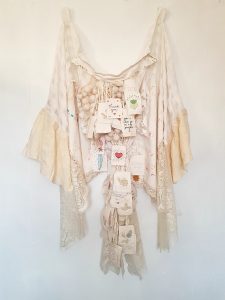
Para kanimo / For you, Greys Lockheart
Karen Zalamea
BIO:
Karen Zalamea is a Filipino-Canadian artist, educator, and cultural worker based in Vancouver, Canada, the unceded territories of the xʷməθkwəy̓əm (Musqueam), Skwxwú7mesh (Squamish), and Səl̓ílwətaɬ/Selilwitulh (Tsleil-Waututh) Nations. Her work has been presented in solo and group exhibitions and as public art projects across Canada and internationally. Zalamea holds degrees from Concordia University (Montreal) and from Emily Carr University of Art + Design (Vancouver).
ARTIST STATEMENT:
Zalamea’s interdisciplinary practice is rooted in photography and critically considers methodologies, materiality, and modes of representation. Her research centers on the camera-mediated relationship between body and space, as well as the material and representational potential of the photographic surface. Her work has expanded to use photography as a means to think through and encounter broader issues of identity, memory, and uncertainty.
PROJECT DESCRIPTION:
Sunken Garden (2020–) originates in the artist’s ancestral house in Quezon City, Philippines. The project considers the house as archive – from the intimate scale of the familial, with each surface holding intergenerational memory, to the expansive scale of resources and building materials. In this work from the series, a visual aggregate of the home’s marble staircase digitally merges the individual steps together to form one monumental photograph, where the veining and texture of the marble is connected in an imagined restoration of the extracted stone to the land. The large – scale image is paired with a constructed photograph of a marble quarry that combines images sourced online. As a growing series, Sunken Garden speaks to the possibilities of bridging distance and to notions of trans – Pacific kinwork through photographic assemblages of speculation, approximation, and invention.
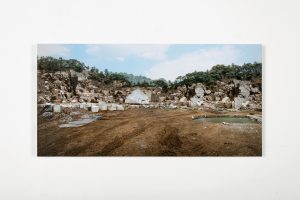
Sunken Garden (Quarry), Karen Zalamea
Marigold Santos
BIO:
Marigold Santos was born in the Philippines and immigrated to Canada in 1988. She pursues an inter-disciplinary art practice involving drawn, painted, and printed works, sculpture, tattooing, and sound. She holds a BFA from the University of Calgary, and an MFA from Concordia University. Marigold Santos is grateful to live and work in Treaty 7 Territory, in Mohkinstsis/Calgary.
ARTIST STATEMENT:
Santos’ art practice explores multiple and hybrid self-hoods while considering the empowering relationships to heritage through a diasporic lens. Narratives of past and present are reconfigured and radically reconceptualized to speak of self-awareness and actualization, transformation, and resilience, in an effort to celebrate and embrace plurality of identities and represent the lived experience as influx.
PROJECT DESCRIPTION:
The otherworldly imagery within these new works reflects on sensorial memories of particular consumables tied to comfort and familiarity, gifted by my family members, and brought back to Canada after a long visit to our homeland. They serve as fragmented and cherished extensions to the time spent overseas, and continue a tethered connection.

shroud (yema), Marigold Santos
Zeus Bascon
BIO:
Zeus Bascon (Laguna, Philippines 1987) holds a Bachelor’s degree in Commerce. Since 2006, Bascon has built his art career through active participation in exhibitions, locally and abroad. He has participated in residency programs such as Fictive Communities Asia: Koganecho Bazaar (Japan 2014), Craft Taitung Creator Exchange Program (Taiwan 2019) and just recently for Emerging Islands (La Union 2021). Bascon was a recipient of the Thirteen Artists Award 2018, granted by the Cultural Centre of the Philippines.
ARTIST STATEMENT:
Through a practice of questioning his own metaphysical relationship to the present, Bascon has become attuned to a variety of apparitions, leading him to create artworks charged with mysticism and the supernatural. His interdisciplinary practice involves the transmutation of form – extracting elements in personal narratives to illustrate the internal and external; the logistics of location; energies stored in time; and evidence of intuition.
PROJECT DESCRIPTION:
Recently, Bascon spent a considerable amount of time with the sunsets in La Union. Looking out over the horizon, thoughts of longing, of loved ones far away linger. Online conversations cannot traverse distances this light can cross. In conversation with this perfect star, it is just as good as a prayer. It is well-wishes to friends. It is hopes and dreams manifested. Can pictures of sunsets warm the heart of a dear sister living abroad?

11 sunset postcards, Zeus Bascon
KoloWn
BIO:
KoloWn artist/collective/automationbot. They utilize collaboration, crowd sourcing and automation on their works. Their works tackle the relationship of public-online-traditional spaces, and investigates how the meaning, materiality, and technique evolve through the intervention and transcendence of those spaces.
PROJECT DESCRIPTION:
crowdsourced trash images from Canada
TradeWinds (taken from the wind that powers European Colonial expansion) is a browser-based work that can be accessed using smartphones, laptops or anything with a web browser.
In response to the current lockdowns imposed to curb the global pandemic, TradeWinds is accessible, as well as flexible in its presentation. For this exhibition, it has been adapted for indoor viewing, but can be modified for different environments.
This work features images of trash crowdsourced from people residing in Canada. Randomly appearing on the screen, the garbage is powerful in its multitude and relentless demand to be seen. Interestingly, the Canadian contributions present a global representation of trash. This is a powerful reminder that such goods cross oceans throughout its lifecycle from raw material to material waste.

Tradewinds, KoloWn

